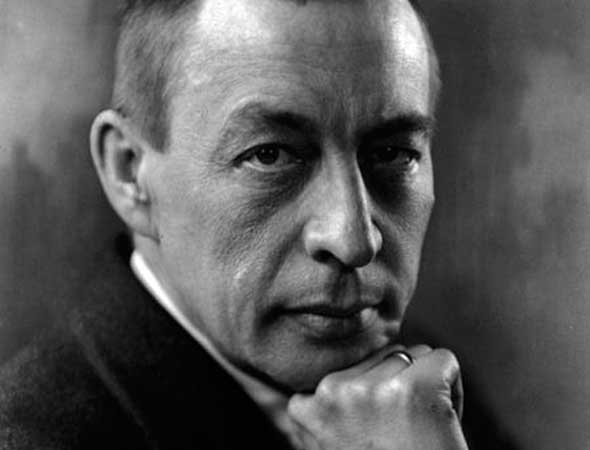RACHMANINOFF: Piano Concerto No. 3
Instrumentation: 2 flutes, 2 oboes, 2 clarinets, 2 bassoons; 4 horns, 2 trimpets, 3 trombones, tuba; strings; percussion; solo piano.

Sergei Rachmaninoff
Bringing a legacy of Russian and Israeli piano pedagogy and Rachmaninoff interpretation to the keyboard, pianist Boris Giltburg is a reminder that our chances of hearing a great performance of a formidably difficult piano concerto, like the Rachmaninoff No. 3, are greater than ever before in history. It takes a superlative pianist to do justice to such a demanding work; but with increased global interest in classical music and advances in music education, there is an unprecedented abundance of talented pianists for today’s classical listeners to hear. With our luxury of listening choices, we can easily forget how different things were in Rachmaninoff’s day, when fewer soloists were prepared to play the great concertos, and when the composers who wrote them were often prominent soloists in their own right.
Sergei Rachmaninoff, the last of the great Russian Romantic composers, was also one of history’s great pianists — perhaps the greatest of all, according to some current re-evaluations. (Recordings of Rachmaninoff exist, and his performances are well documented.) With Frederic Chopin, Franz Liszt, and the great Baroque organists like Bach and Telemann, he was one of classical music’s legendary masters of the keyboard who were also great composers. Of these, he was an heir of Liszt — whose works demand power, speed, and fire — rather than the poetic, introspective Chopin.
If Tchaikovsky was the central and best known of the Russian romantic composers, and if Glinka was the first and the father figure, then Rachmaninoff embodied their artistic culmination. As a conservatory student in Moscow and St. Petersburg, he focused intensively on both piano technique and composition, and he was recognized as a great pianist throughout his career; just before his death, he was touring the U.S. as a piano soloist. Despite his latter-day moodiness and a bit of harmonic adventurism, you can hear that his style was rooted in the 1800s and in Russia as deeply as his predecessors’.
But Glinka and Tchaikovsky remained in the motherland and died there in 1857 and 1893, respectively. Listening to Rachmaninoff ’s long, brooding lines — their sweetness tinged with melancholy — it is surprising to learn that he died at his home in sunny Beverly Hills as recently as 1943. Another Russian expatriate composer, Igor Stravinsky, had come to the United States in 1939, became a naturalized U.S. citizen, and spent time living in Los Angeles. But as a composer, Stravinsky already inhabited a very different, more modern era.
Rachmaninoff’s hallmarks are dazzling virtuosity and plush melody. Big intervals and big sound were natural parts of his musical vocabulary, and seemed to come naturally to his huge hands and long limbs; in fact, it is now believed that he had Marfan’s Syndrome, a congenital condition associated with these skeletal proportions. But if Marfan’s contributed to his heroic sound, there was a more delicate aspect to the Rachmaninoff style — fleet passagework, rhythmic pliancy, and long, singing lines. His third piano concerto is known to many pianists as Rach 3, or — thanks to Sylvester Stallone — as Rocky III because it is so formidable a heavyweight.
The difficulties lie in Rachmaninoff’s unique combination of power, poetry and speed. Those huge, complex chords, thundering octaves, cascading phrases and purling legatos might be nearly impossible to play, but should sound effortless as they hold you in their thrall. It’s only afterwards, when you are released from their spell, that you might wonder how in the world the pianist played them with only two hands. Rachmaninoff’s music asks much of a pianist: power, speed, the ability to spin out a deeply sculpted legato line, and sometimes all three at once. Not surprisingly, his third concerto is associated with some of the greatest pianists of the early 20th Century. Its dedicatee was the revered Josef Hoffmann. Though he never played it, 11 years later it would help launch the career of an astounding newcomer named Vladimir Horowitz, who chose it for his graduation recital at the Kiev Conservatory and was soloist in the premiere recording.
The composer felt that his third concerto was more “comfortable” to perform than his second, but now, more than a century later, the sheer virtuosity required in the third casts a longer shadow among pianists. Could Rachmaninoff really have found these demands so manageable? Composed in 1909 for his first major performances in America, the concerto was a spectacular showcase for his particular gifts. Touring with the Boston Symphony Orchestra, Rachmaninoff was both soloist and conductor in Chicago and Philadelphia; in New York he played the concerto with the New York Symphony Orchestra under the baton of Walter Damrosch, and with the New York Philharmonic under the direction of Gustav Mahler.
Written in the three-movement form typical of Romantic concertos, the Piano Concerto No. 3 is replete with Rachmaninoff’s stylistic hallmarks: dazzling virtuosity and plush melody. It begins with an allegro movement in D minor in which the opening statement, a simple melody, is juxtaposed against a slower theme. They frame a characteristic Rachmaninoff development section, with brilliant passagework and thundering climaxes that create intense drama before the original theme reappears in relative tranquility.
The concerto’s second movement, marked intermezzo, reveals what many listeners value most in Rachmaninoff: a melody of intense, swooning romanticism that goes wherever its organic, spontaneous development seems to lead it. Introspective in character, it builds gradually from quiet nostalgia to dramatic fortissimos that showcase the soloist’s power. This development is mediated by the reintroduction of the main melody from the first movement. Solo flourishes from the piano lead directly from its close. In a work that is both a sprint and a marathon, this movement provides the few moments of respite for the soloist.
Grace and speed are on order for the final movement, which builds toward a powerful climax by weaving together contrasting materials: accented march rhythms alternating with flowing, lyrical phrases. The movement reprises melodic materials from the concerto’s opening, concluding with a coda of thrilling power.












